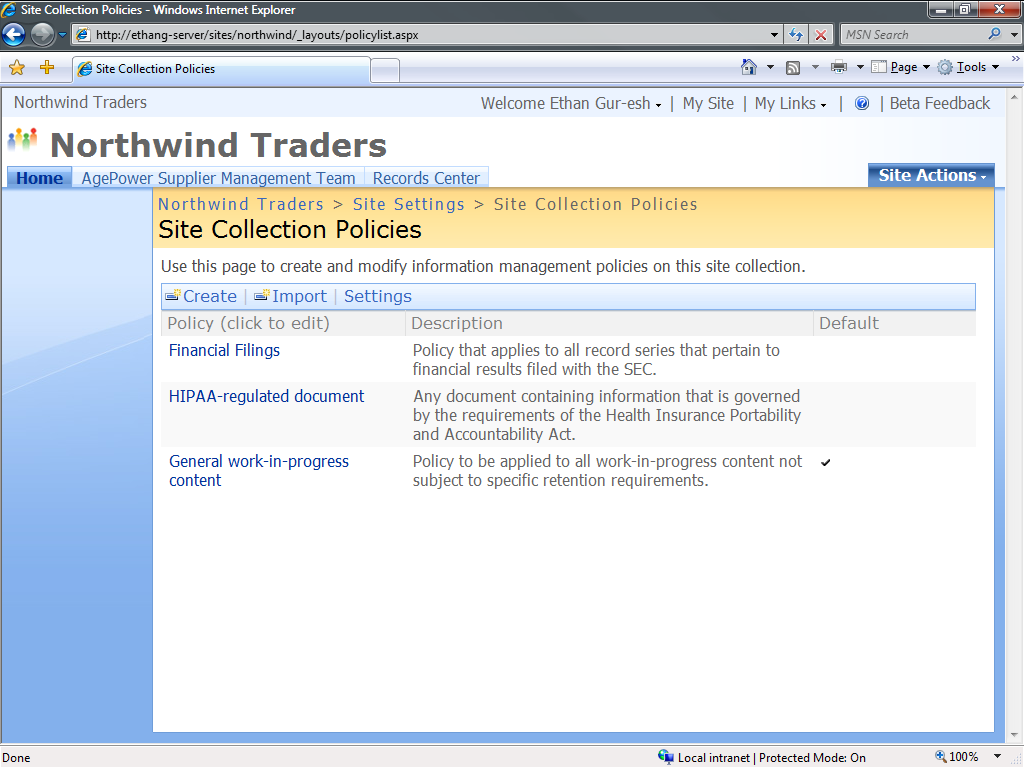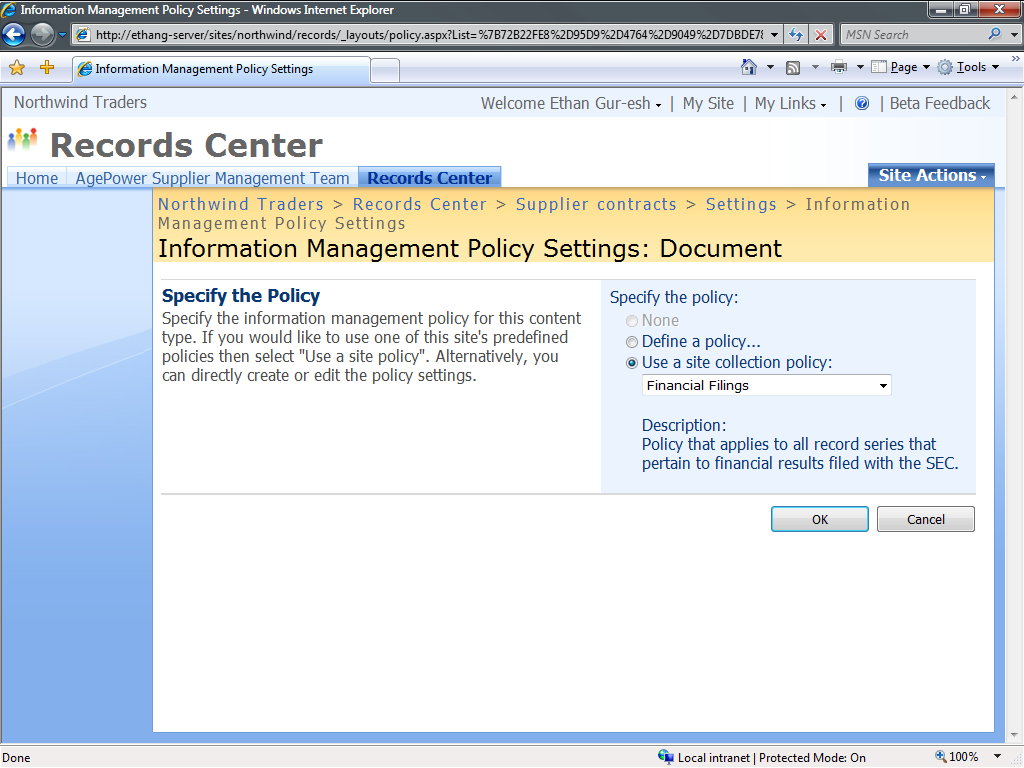Records Management Feature: Information Management Policies (Part II)
In our last post, we introduced the concept of Information Management Policies in the 2007 release of the Microsoft Office System, and the different capabilities that can be implemented using these policies.
In this post, we’re going to discuss how policies can be used to manage both records spaces and collaborative spaces. (This will be especially helpful when we start looking at the different policy features, because many of them will be applicable in both collaborative and records scenarios.) Also, it will help explain why we built the information management policy re-use/administration capabilities into the 2007 release of Office SharePoint Server, since many of these are focused on retention management of content in collaborative spaces.
Information Management Policies in records spaces:
First, let’s talk about a scenario near and dear to most records managers – how information management policies can be used to enforce retention schedules in a records space. Since these spaces are generally controlled by records managers each list, document library, or content type can be manually configured with an appropriate policy to control a records retention schedule and disposition. However, even in records spaces, it may be the case that there are several record series whose retention requirements are the same -- for example, because the retention schedule for each is driven by a common regulation or legal requirement.
For these types of scenarios (and others that we'll see shortly), the 2007 release of Microsoft Office SharePoint Server includes a Site Collection Policies gallery -- this is a central gallery of policies that can be authored once and then re-used across multiple lists, document libraries, and content types. The benefit of this re-use is that, should that policy ever need to be modified (for example, if a new legal interpretation of a regulation occurs), then that change can be made once to the policy in the gallery, and all of the locations using that policy will be updated accordingly. Here is an image showing the Site Collection Policies gallery (Note: Clicking on this image should bring up a larger version) :
You author a site collection policy in the same way you author a policy for an individual list, library, or content type. And once a site collection policy has been created, it can be used in lists, document libraries, and content types by selecting the policy by name in the appropriate “Information Management Policy Settings” page, as shown below:
(Note that the description for the currently selected policy is shown on this settings page… that will be a particularly important point for the re-use of site collection policies in collaborative spaces.)
Now let's look at how policies (and in particular, the capabilities of the site collection policy gallery) can be applied & used within collaborative spaces, which are generally not as tightly controlled by a records manager.
Information Management Policies in collaborative spaces:
Although the records manager usually controls each document library, list, and content type in a records space, that isn't true for most collaborative spaces in an organization. However, these spaces still need some level of "retention management", to ensure that work-in-progress content is kept for an appropriate period of time, that any required audit trails are recorded for important content, and that other best practices are implemented. For this reason, we've made all of the information management policy capabilities available in all types of sites in Office SharePoint Server 2007 -- not just sites used to manage records.
In sites in collaborative spaces, the re-use of site collection policies are especially important because they allow records managers to define centrally the appropriate policies for different types of content in a way that collaborative space owners can easily incorporate into their own document libraries, lists and content types. In this way, site owners need only make the minimal decision of "which of the pre-defined policies is appropriate" for each location or type of content... and this policy still remains “transparent” to end-users, who just use the content types, lists, and document libraries to go about their regular work without needing to know about the information management policy.
So as you can see, information management policies provide a powerful set of tools for records managers to both manage records according to file plan AND to perform an appropriate level of "retention management" in their organization's collaborative spaces.
In our next few postings we'll examine each of the different policy features that can be incorporated into a policy, including how each is relevant to both collaborative and records spaces.
Thanks for reading!
- Ethan Gur-esh, Program Manager
Comments
Anonymous
August 03, 2006
Here is an assortment of various 2007 Microsoft Office SharePoint Server Documentation / Reference Materials...Anonymous
August 30, 2006
Planning Plan document management Chapter overview: Plan document management What is document management?Anonymous
September 10, 2006
Is it possible to access the Information policies programmatically?
If so, can they be assigned programmatically to a list/ content type?
And then retrieved?
Thanks,
YuriAnonymous
September 12, 2006
@PRJ-Yuri:
Yuri,
These types of questions are better posed to the Office Beta newsgroups -- see http://www.microsoft.com/office/preview/community/newsgroups.mspx for a listing of these newsgroups. We're trying to focus this blog on the broader aspects of the Records Management functionality in the 2007 release.
But since you asked:
Yes, it is possible to access the Information Management Policies programmatically, both in the Office 2007 client applications and in Office SharePoint Server 2007. In the client applications you can access the policy defined on the current document. On the server you can both access and set the policy on a particular Content Type.
If you'd like more details about the specific code required, please follow up on the newsgroups or via the "Contact" form on this blog.
Hope this helps,
- Ethan.Anonymous
October 03, 2007
Document and Records Management Definition Document Management According to Wikipedia : "A documentAnonymous
November 12, 2007
2007 MOSS Resource Links (Microsoft Office SharePoint Server) Here is an assortment of various 2007 MicrosoftAnonymous
July 27, 2008
Document and Records Management Definition Document Management According to Wikipedia : "A documentAnonymous
May 29, 2009
PingBack from http://paidsurveyshub.info/story.php?title=microsoft-records-management-team-blog-records-management-feature-4Anonymous
June 15, 2009
PingBack from http://workfromhomecareer.info/story.php?id=9538Anonymous
June 16, 2009
PingBack from http://fixmycrediteasily.info/story.php?id=12033

